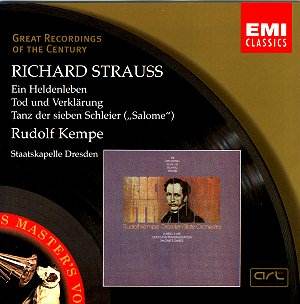Rudolf Kempe was a supreme interpreter of the music
of Richard Strauss. Having played the music (as an orchestral oboist)
himself, he had an acute understanding of the brilliance of Strauss’s
instrumentation. He also had a gift for flexibility of phrasing, without
ever losing sight of the fundamental pulse of the music. This last is
in contrast to Herbert von Karajan, who often displayed a maddeningly
cavalier attitude to the precise value of sustained notes or rests.
In the Dresden Staatskapelle, Kempe had the perfect
instrument for this music. They have the pedigree and the sense of style,
and a sheer beauty of sound which is second to none among the world’s
orchestras (or they certainly did in Kempe’s day). The strings have
a glorious bloom with added brilliance, the brass are massively powerful
yet superbly blended, and all the woodwind players are soloists in their
own right. Add to that a recording which, even allowing for EMI’s brushing
up, was years ahead of its time, and you have a really wonderful musical
experience.
The Dance of the Seven Veils is a mere hors
d’oeuvre to the sumptuous fare which follows. It’s worth hearing,
though; Kempe brings out the visual qualities of the music, its sinuous,
sensuous evocation of Salome – one of the first lap-dancers? Then it’s
down to the serious business. Tod und Verklärung is an inspirational
piece, especially coming from a young composer (just 24 when he began
it), though it needs to be handled carefully if its rhetoric is not
to spill over into bombast. No danger of that here; Kempe’s sensitive
balancing of tempi and texture means that the music builds inexorably
throughout. The opening catches the ‘sick-room’ atmosphere perfectly
(looking forward to the Prelude to Gerontius), and the Allegro
music which follows expresses the agony and physical weakness of
the dying man, without going ‘over the top’. The final ‘Verklärung’
has a serene, glowing quality, leading ultimately to a final chord of
C major which is one of the most beautiful things of its kind that I’ve
ever heard.
Ein Heldenleben is, of course, a very different
kettle of fish. It is a programme symphony based on the life of a ‘Hero’,
who is in fact none other than Richard Strauss himself. I’ve always
found it hard to believe that a composer with as highly developed a
sense of humour as Strauss could compose a piece so shamelessly self-laudatory
as this without his tongue firmly in his cheek. And there is a great
deal of humour in the work, from the obstreperous dissonances of the
Critics to the garrulous violin cadenzas depicting the composer’s wife,
Pauline.
Kempe and his Dresden players capture perfectly the
‘larger-than-life’ sides of the music. When the music calls for it,
they give it the full treatment, notably in the blood and thunder of
the battle scene, the earlier love music, or the crepuscular duetting
of horn and violin that brings the work to its tranquil end. The playing
is sensational; One moment in particular made me laugh out loud. After
the battle sequence, the music approaches a clinching cadence in Eb
major. Most of the orchestra rises up a scale of Eb, while the eight
horns in unison move downwards. As the final top note is approached,
the horns can’t wait any longer and make a huge concerted leap for the
top Eb, seizing it triumphantly just before everybody else. (One
of the reasons I laughed was because it reminded me of a brilliantly
funny lecture by Stephen Banfield on ‘The Horn as Phallic Symbol in
the Music of R.Strauss’. Surely a case in this instance of ‘ejaculatio
praecox’?)
I should mention, finally, the contribution of the
leader, Peter Mirring, who plays the immensely demanding violin solos
with exquisite beauty. All in all, a heady experience for Strauss lovers,
or anyone who loves great orchestral playing. No collection should be
without it.
Gwyn Parry-Jones


